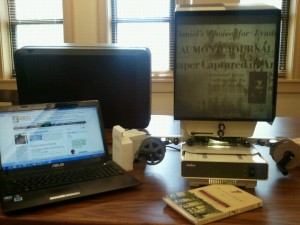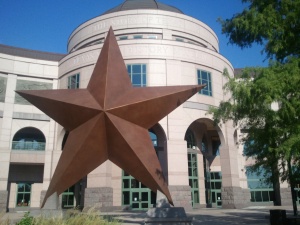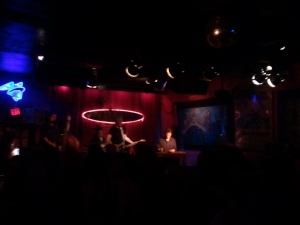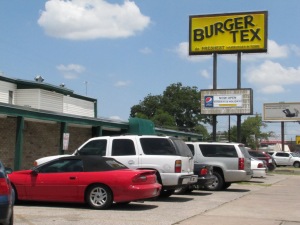Wednesday, August 8
When I was visiting my family in Houston, we naturally talked about my trip.
“So, where are you off to next? Where is the next stop?” my cousin asked.
“Well, from here I leave to Beaumont for a minute. Then Lafayette, Morgan City, Houma, New Orleans… then up through Mississippi and Alabama all the way to Virginia.”
At the mention of Beaumont, my aunt’s face darkened a little and grew a strange, puzzled smile.
“You’re stopping in Beaumont?” she asked
“Yeah?” A light question mark at the end.
“Why would you ever want to do that?” she laughed as if she had been holding back some unpleasantly funny thought. “It’s the–armpit of Texas.”
This was the first mild warning I had received about Beaumont, and it wouldn’t be the last. I am, however, completely foolhardy most of the time and incredibly stubborn some of the time. Though I was talking to someone who is essentially an “Honorary Texan,” I chalked up my aunt’s critique of Beaumont as a product of her being a Southern Lady: as if Beaumont was a rough-and-tumble Texan town with bar fights and casinos, ringed in by oil refineries. No such place for a lady.

Babe Zaharias Museum and Visitor Center
When I drove in to Beaumont, I stopped at a gas station to ask for directions into town. Luckily I stopped next to the information and tourist center, so I sauntered over. I’m still not exactly sure what this building was. It was half information hub for Beaumont, half shrine to local athletic legend, Babe Zaharias. Actually, the ratio was more like 80-20 in favor of Babe.
Maybe I’m a brute who didn’t do as much research as I should’ve, but I’ve never heard of Babe before. She was, allegedly, one of the greatest athletes of the 20th century. Judging by this one-room sanctuary the city of Beaumont has established, it would be easy to think that Jonas Salk might have been a little dishonest and Zaharias was the real scientist.
The woman behind the counter seemed frustrated that I was asking about the city and not about Zaharias. Instead of directions, she gave me a map, which was more probably convenient, albeit, telling of how little effort she wanted to waste on me. Did I smell that bad? I was polite enough to look around at all the artifacts left by this legendary woman. As I left, the woman all but yelled, “Hey! Could you sign my guestbook?” In the small domed room, her voice froze me in my tracks. I wanted to run. Fast. I almost bolted to the door in terror but made the mistake of looking back at her–into her eyes. I was a pillar of salt.

Behold! The dog’s idol and deity!
I signed a distant relatives’ name and got out. Not the best intro into this city, and the whole experience was downhill from there. I passed by “The World’s Largest Fire Hydrant” on my way to the library downtown. It sure was a big fire hydrant. Painted up like a dalmatian. Stay positive, I thought. This place isn’t that bad yet. You have no right to be cynical yet, dammit.

Tyrrell Historical Library in Beaumont, TX. Medieval design. Medieval equipment.
I found my way into the Tyrrell Historical Library. It’s a very pretty library which resembles a medieval castle a la Texas. I was going to look at newspapers from the weeks in 1960 when Steinbeck was in the area. In Travel’s with Charley, he describes Thanksgiving in Amarillo. Schools in New Orleans were desegregated on November 14, 1960. On December 2, 1960, he sent a postcard from the Pelahatchie, Mississippi post office to his wife in Sag Harbor. That means from around November 24 to December 2, he was anywhere between Amarillo and Pelahatchie. I needed to see what was going on in Texan newspapers all around that time.
I talked to the lady at the desk who led me into the microform room. She said I have to leave my backpack, but I can take my computer and whatever else I need. That is important. I went back and found what I needed with the aid of an incredibly slow-talking guy. I’ve recently become aware of the fact that I have tendencies to talk pretty slow, but this guy was definitely the tortoise to my hare. He was a great guy, though, who was pretty helpful overall.

Only two of those buildings have businesses inside them. The rest are dust and empty.
After a few hours in the room, I got hungry. The other gentleman, a slightly stooped, balding man with a high-alto voice, advised me to partake in a sub shop that was around the corner. This was my first real look at downtown Beaumont, and there wasn’t anything to look at. It looked like a shanty town. I would say that 70 percent of the buildings downtown didn’t look open. 30 percent of those were actually boarded up. It’s so strange. “Other times I have come to Beaumont dripping with sweat and lusting for ice and air-conditioning,” Steinbeck wrote about his drive through in November 1960. “Now Beaumont with all its glare of neon signs was what they call froze up.” Well it’s August. I’m dripping with sweat, and Beaumont is still “froze up.” No neon to be found. I don’t know why, but I’m not sure it ever thawed from Steinbeck’s time. It really weighs in on the soul to see such degradation in a town. It has such potential. It was probably once a booming place, but now it has fallen into a hot, dusty sleep.
I had an amazing Reuben sandwich from Chuck’s Sandwich Shop–the one that’s open, not to be confused with the one that is barred shut across the street. The High Alto gent was right and props to him.
On returning to the library I left my bag again. That is, again, important. And that is where my day went to hell in a hand basket and all of Beaumont with it. I began to find all the articles I needed and get them ready for printing. Once I was ready, I realized there were two other people ahead of me for the microform printer. By the time they finished, it was 4:30 p.m. The library closes at 6.
“You’ve got about an hour and a half to wrap everything up,” said the slow talking guy after a lengthy tutorial about how to use the printer.

Doing work before my fateful printing experience.
Basically, the printer was overheating because of the heavy toll of having three people use it in one day. Not only that but the gears that wind the film were old and had to be wound by hand. This would not be an issue if I wasn’t trying to print two pages from fifteen different issues of two different papers. That means almost sixty pages. Here I am, getting steadily more angry, winding the film into place, adjusting the toner, clearing the printer of a jam every other print, and all with Slowtalking McGee standing over, chiming in every fifteen minutes about how much time I have left. To be fair, he helped a great deal and offered some words to pacify.
“Man. I’m sorry about all that,” he said. “That machine is just old and a few people have used it today. Man, no one ever uses that machine, and it goes to figure that the one day everyone uses it is the one day someone like you really needs it.”
Thanks. Man.
I left in a mild frenzy with less than half of the articles I had planned to have. I walked to my car in a different parking lot, set all my stuff down in the seat, and think to myself, I just want to get out of here. If I get on to Lafayette, everything will be alright. Key in the ignition. Click. Click-click. Cli-cli-cli-cli-click. I noticed the headlights were left on. Yes. Great. I love it. Fifteen minutes later, just as I was about to call AAA, a woman walked by. She looked at me like I was a leper, but I convinced her to jump me off. She does while eyeing me suspiciously and texting the entire time. I thank her, jump in my car, and blaze for the interstate. About halfway there I reach for something in my backpack. Well… where did it g-… No. Yes. It was in the library. The library that closed thirty minutes ago.





















